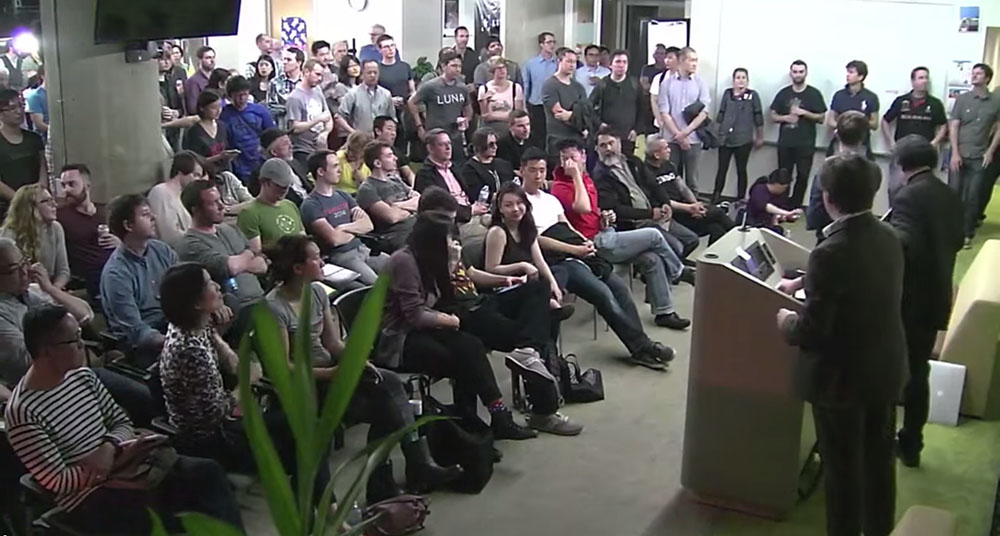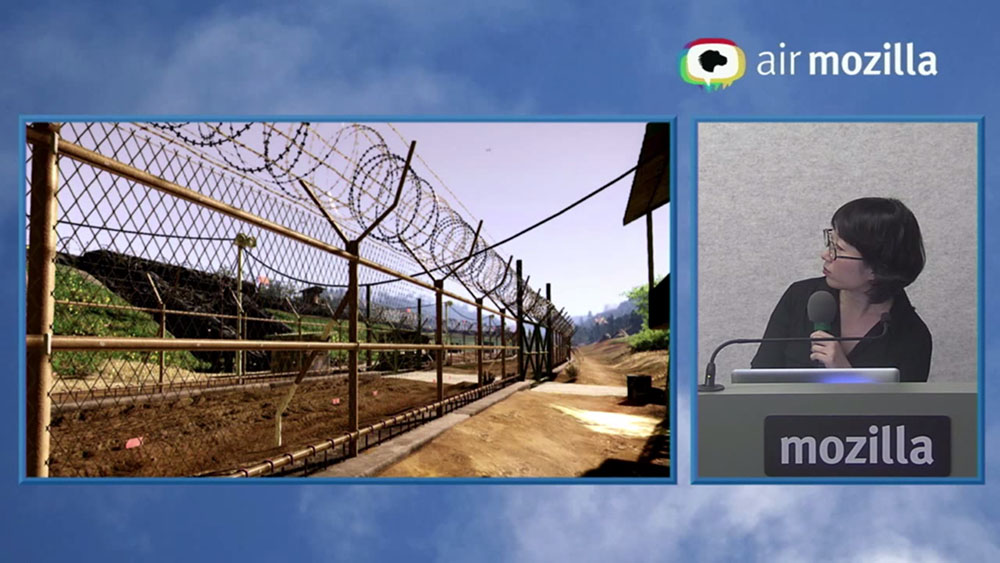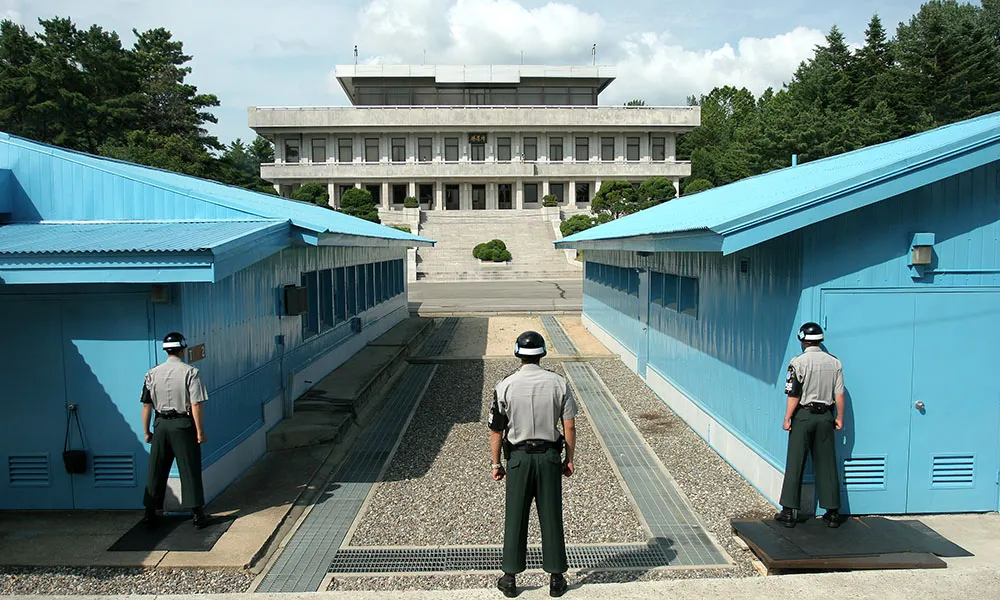The three ‘new visions’ presented at VR Cinema #3 had an odd similarity: they are all based on old art forms. I suppose this is how the medium of VR will progress, by adopting and extending traditions of older media. But it also lays bare the state of VR Cinema: there’s no clear canon yet, no set of VR-specific traditions, and no shared language — just borrowed languages and metaphors. Tellingly, the projects all used or re-used existing content from other media. But that’s okay, it’s still early in the history of the medium, and the trailblazers at VR Cinema #3 spoke with interesting voices.
The format was standard VR meetup: the artists gave slideshow presentations about their projects followed by Q&A, then the standing-room-only crowd scattered for headset demos and discussion. The mood was very casual, like a friend’s loft party, minus the loud music.
Or maybe it was more like an underground art show. The first presentation, “Cinechamber,” certainly belongs in the warehouse scene: a product of Recombinant Media Labs (RML), it repackages immersive installation art into a VR space. RML is the brainchild of artist Naut Humon, and digital entrepreneur/artist Steve Mason ported the content to VR.
Humon has been building immersive audio (and later video) spaces since the 1970s, though RML itself only dates back to 1991. In its live theater incarnation, RML installations feature footage projected onto 10 screens arranged in a rectangle; crowds experience the visual and audio art inside the ring of screens. (The project is ongoing, and the installation pops up around the world at museums and festivals.) The VR experience is similar; Mason faithfully ported the experience into a Unity environment, including fine details like the triangular truss holding up the screens.
The footage projected on Humon’s physical screens and Mason’s digital screens is very experimental. It’s glitchy, abstract, distorted, synthesized. Some is built from moving buildings or people, or rapidly morphing shapes, colors, and lights. The RML archive has works from about a dozen different artists with divergent styles, but the format clearly favors surreality over reality. Cinechamber isn’t a window into another world, it’s a set of goggles for artists to splash digital paint onto.
And in a strange way, Cinechamber is both proof and counterpoint to VR as the ‘last medium.’ It wraps the installation into a headset, reducing projectors and screens to bits. But it also takes something tied to a specific place and time and abstracts it, vaporizing the crowd, leveling the theater and injecting the content directly into the viewer’s eye sockets. Mason described the project as a form of art preservation: allowing these temporary installation pieces to be preserved and experienced in the future. But it’s more radical than preservation, it’s transmogrification. The result is interesting itself, but like the transition from analog to digital, some of what’s interesting is what can’t be reproduced — the tape hiss, the murmuring crowd gone missing.
(It’s also funny that this experiment is older than VR itself: Humon was playing with audio installations before Jaron Lanier ever put on a headset. It makes VR seem more like a stop along the way rather than the final medium.)

In contrast to Cinechamber’s experimental weirdness, Innerspace VR’s “DMZ” feels like a careful exploration. Based on CEO Hayoun Kwon’s 2010 documentary film about Korea’s Demilitarized Zone, “DMZ” takes the viewer into the forbidden space between North and South Korea, a 4 km wide strip that bisects the Korean Peninsula. It’s more traditionally VR — if ‘traditional VR’ isn’t totally oxymoronic — because it puts the viewer in a human-scale space, walking through a wild corridor between two armed nations. In reality, nature has overtaken the strip of land, uninhabited for 60 years, though it has more landmines than any other place on earth. In virtual reality, the scenery is equal parts human-built and wild, with the viewer’s flashlight glinting off of metal gates and forest streams.
This is how “DMZ” plays to the inherent strengths of VR as a medium, by transporting the viewer to a specific time and place: today, around the 38th parallel, surrounded by barbed wire and mines, streams and pine trees. It’s haunting to know the animated trappings of war aren’t fictional. In Korea, these guns are rendered in steel.
“DMZ” is the most political, cultural, and personal work of VR I’ve heard of to date. And while the VR format seems radical, it feels more like an extension of the documentary tradition. It forces the viewer to empathize with the subject by putting her in the same place as the subject — like Errol Morris’s “Interrotron” turned up to 11. In this case though, the viewer becomes the subject: the VR film follows the footsteps of a South Korean soldier patrolling the DMZ while listening to his memories in voiceover.
The scenery was all generated by hacking Cryengine, but is pre-rendered to play back smoothly (so no head-tracking in the DMZ). The film is a work in progress; it’s taken five artists working five months to get this far, and Innerspace’s Balthazar Auxietre estimates it will take another two months for the team to finish. (He also put out a call for Sean Penn to complete the English voiceover narration, but Sean was either missing from the meetup or shy.)
I have to confess, I was surprised to learn Innerspace is such an international group: it’s a Korean company staffed by French programmers and animators, per Auxietre. I’m surprised because Innerspace developed some launch content for the Gear VR (“The Fifth Sleep” and “Cave of Dreams”), and it never occurred to me that those pieces weren’t natively anglophone. It’s not that I explicitly assumed it was a US production, it simply never occurred to me it wasn’t — there weren’t any markers of origin that I could discern.
Perhaps it’s also a reminder that the tools for computer-generated VR, even high quality VR, aren’t as expensive as live action film. Leave aside the impossibility of visiting the actual DMZ with a camera, there’s no Hollywood premium to be paid for CG content, just vision and hard work — so perhaps VR is inherently more international, more inclusive than traditional film. (Or maybe that’s just true of some CG virtual reality. For now.)

This assumed statelessness also throws a spotlight on the blank slate of VR Cinema: there aren’t regional traditions, or local industries yet. No Bollywood, Nollywood or Hong Kong studios, no French New Wave, German Expressionism — just a bunch of innovators exploring a new medium. Or maybe I’m being parochial, maybe VR was always meant to be placeless, transnational.
But if “DMZ” seems more grounded in reality than Innerspace’s other works, there is a common thread. “The Fifth Sleep” and “Cave of Dreams” explicitly pull the viewer through dreamscapes and into imagined realms. Similarly, “DMZ” plumbs the subconscious, choosing instead to weave the narrative from memories. And though it takes pains to place the viewer in a specific location, “DMZ” shows the limits of the medium: it’s a rendered space, without the fine texture of reality. The film’s DMZ is synthetic, which places the project back in the realm of phantasm. Perhaps this pushes the documentary beyond pure recollection, and into reconstruction, interpretation. These boundaries, between real and imagined, computer-generated and live-action are worth exploring (and blurring) in VR cinema.
The most explicit artistic lineage of the night belonged to Michael Catalano’s “Bright Shadows.” Like Cinechamber, it repurposes work created for a theatrical medium. Catalano re-rendered his master’s thesis, an immersive experience meant for theatrical projection, into a VR experience. He cites the tradition of “visual music” as the basis for his work, and name-checks the likes of Kandinsky, O’Keeffe, and a passel of experimental animators when describing his work.
And if there’s resonance with the Cinechamber work, that’s understandable; they nominally are moving between the same media. But the contrast with “DMZ,” as bookends, is remarkable. If “DMZ” is about time and place, Catalano takes the VR experiment further away from the concrete world into pure abstraction. The explicit goal, he said, is to generate feeling and emotion in the viewer without reference to person, place, or thing.
The work itself consists of geometric shapes synchronized to “Ombres Lumineuses” by Costin Miereanu, itself a riot of arhythmic percussion, chimes, and unidentifiable clangs, set against a spare background of silence. Similarly, Catalano’s abstractions bounce and weave with the music against a formless black, the curves and spikes of their morphing shapes reflecting the acoustic shape of the instruments they spring from.
And Catalano took pains to tie his visuals to the music. To bind them together, he spectrally isolated each instrument and animated the movements of his shapes to their sounds, so the movement of the images is drawn algorithmically from the texture of the music itself. The hardest part, he confided, was getting the shapes themselves to respond to the music, stretching, warping, and squashing along with the sounds — Catalano calls it “procedurally generated geometry,” but it feels a lot like dancing.
Catalano did his musical deconstruction and procedural animation in Side Effects’ Houdini package. Significantly, he insists on pre-rendering the footage for artistic reasons, not performance considerations. “I prefer to make [my art] hand-crafted, choreographed,” he said in reply to an audience question about interactivity. It’s telling that the VR audience assumes interactivity, even in a cinema-oriented meetup. Equally telling when the artist rebuffs interactivity; in traditional cinema, interactivity is impossible, so your passivity means nothing. Here, it’s a choice.
So maybe the project of VR cinema is a negative construction: in a space that’s inherently interactive, what may distinguish ‘cinema’ is its lack of game-ness, interaction, or a social layer. Perhaps we should reserve ‘cinema’ for the passive form of content: sit back, and let the auteur pour content into your eyes and ears. Perhaps this divide between games and cinema is an artistic DMZ, both sides using the same tools but directed to different ends: on this side, cinema, the unchallenged use of the word ‘art’; on that side, games, interaction, new media … but I suspect not. I think Catalano’s position is part of a continuum, and some art and artists will slip back and forth easily.
There wasn’t much time to debate the finer points, though — the audience was anxious to see the content. And that’s the worst part of the VR presentation meetup: the endless wait to try the experience yourself. The presenters (and a smattering other artists and creators) did their best to cycle people through, but the headset-to-human ratio was, as always, very low. There were a lot of very good discussions about VR, though.
And maybe that’s the weakness of a VR experience, versus the old media: we the audience got out of our chairs and stood in lines for a chance to experience a theatrical art in a VR headset, when it would’ve been so much quicker to project the images for us all at once, on the walls of Mozilla HQ. Maybe I’ll suggest that next time — we’ll see how it goes over.





























